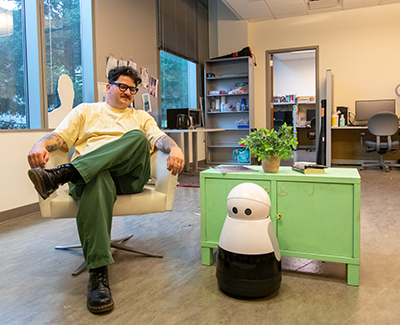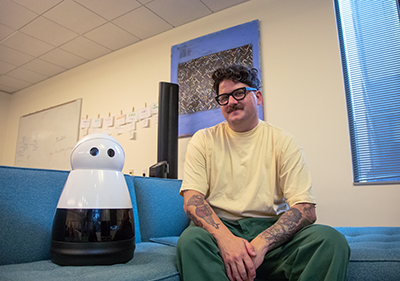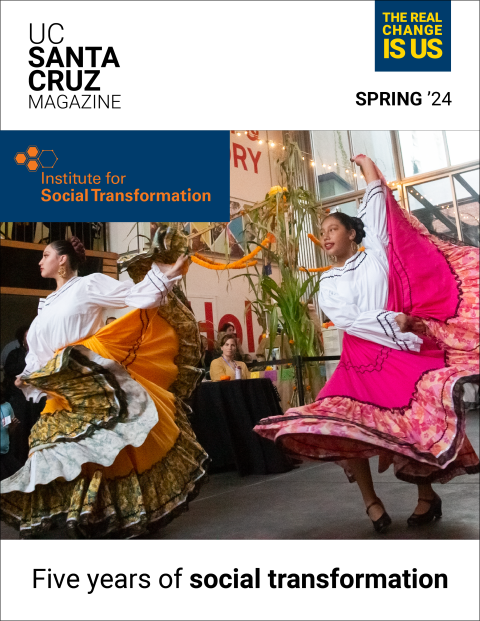Kevin Weatherwax's educational path has not been traditional, but it has kept him closely connected to his home community of Santa Cruz. Now as a computational media Ph.D. student at UC Santa Cruz, part of his research is devoted to the study of adaptive technologies for neurodivergent adults, in addition to his research on human-robot interaction.
This work has been recognized through the Piatt Fellowship, an annual scholarship award given by the Rotary Club of Capitola/Aptos to a UC Santa Cruz Natural Sciences doctoral student who went to a public high school in Santa Cruz County. This scholarship is crucial, he says, in allowing him to continue his education while he raises his daughter locally and sees the cost of living increase.
“I believe in localized living—this is where I live, this is where my home is,” Weatherwax said. “I think there's a lot of value in encouraging people to be scholars in their own community.”
Weatherwax’s connection to the community runs deep. He’s lived in the area since he was 10; his parents are in the community; his wife, Noelle Stapleton, owns a small business, Ritual Curl Studio, in Santa Cruz; and his daughter is in a safe and supportive educational environment. The Piatt Fellowship is essential to allowing him to maintain these ties and stay in Santa Cruz.
“It’s really cool to see a local organization that supports academics in the community, and tries to bridge that gap between the town and the campus,” Weatherwax said.
Supporting homegrown scholars
Weatherwax is one of the 409 students currently enrolled at UCSC whose home county is Santa Cruz, and the 10th UCSC student to win the Piatt Fellowship. Members of the Rotary Club of Capitola/Aptos, which is dedicated to service in the community, recently visited campus to see Weatherwax’s lab and learn more about his work.
“It’s very rewarding to see what this fellowship can do,” said Kendra Cleary, co-president of the Rotary Club of Capitola/Aptos. “It’s encouraging the best and brightest to make a difference, and to return to our community to learn and make that difference.”
Weatherwax’s education has been marked by a series of stops and starts, and his life has been strongly shaped by being neurodivergent. After being expelled from several high schools in Santa Cruz, he dropped out for about a year and ended up graduating late. He struggled with taking college courses, eventually returning to continue his education in his late 20s at Cabrillo College. Through incremental steps, he transferred to UC Santa Cruz, where he got his undergraduate degree and is now pursuing a doctoral degree.
“I’ve always had to work in ways that are different from how other people work,” Weatherwax said.
Lo-fi discovery
While he was an undergraduate, he discovered lo-fi music stations on YouTube, smooth hip-hop beats accompanied by a cartoon loop of a character getting back to work. These channels, which were in their infancy in Weatherwax’s undergrad days, now consistently get tens of thousands of viewers at any given time and have expanded across many platforms.
Weatherwax noticed that when the character in the video clip would get back to work, it would prompt him to get back to work when he found his attention lolling.
“I thought that was really strange, that I was taking behavioral cues from a 10-second animation loop that I would watch all the time,” Weatherwax said. “I got really interested in it.”
With a few friends from the UCSC Computational Media Department, he got started on some passion research looking at lo-fi media as a study tool. This evolved into data collection of chat logs and interviews, which led him to realize that some proportion of the people using lo-fi media were neurodivergent and using it as a form of assistive technology.
“This thing helped them to connect to their work, to focus, to be calm and collected, and to have some kind of sense of safety,” Weatherwax said. “There’s a lot going on there, but it’s kind of an unknown area.”
Neurodivergent connection
Weatherwax continues to be interested in how neurodivergent people may be using lo-fi music and other similar forms of media as a co-opted piece of assistive technology, to provide emotional regulation that may allow them to better focus on work. He especially appreciates how this technology does not try to change the perceived obstacles associated with being neurodivergent.
“The thing with assistive technology and neurodivergence, especially for adults, is that there's not much of it, and it tends to be about trying to train somebody to act neurotypical and overcome or move beyond their neurodivergence.” Weatherwax said. “[Lo-fi tech] doesn't try to strip something away from them, it just augments what they've already got going.”
Now, he says, you can find a lo-fi station with a cartoon from any cultural, religious, or even political affinity. And theories of body doubling, a strategy for mirroring behavior to increase productivity, offer new ways of understanding why lo-fi stations may be so helpful for some.
Weatherwax hopes to continue to pursue this area of research, possibly even as a postdoctoral student at UCSC. But currently, his attention and the main thrust of his graduate research is directed toward his other main research interest—the subtleties of human-robot interaction.

Robot expressiveness
As an undergraduate student, Weatherwax studied psychology and worked for several years as a mental health counselor in Santa Cruz. He brings this social science perspective to his research, which mainly looks at how people perceive and respond to interactive, non-human agents. These could be robots, chatbots, or other forms of interactive artificial intelligence technology, and they are often in a collaborative learning situation with humans.
Weatherwax is particularly interested in how implicit communication, such as intonation, body language, and facial expressions, plays a role in human-robot interactions. He studies both how people may communicate with a robot via these more subtle cues, how those responses can be substituted for more direct feedback from humans, and how robots might be able to express messages back to humans via movement or other ways of expressing intention. He collaborates with clowns, actors, and athletes to learn more about how they convey emotion, and how this could be translated to expressiveness in robots.
One area Weatherwax is interested in applying this to is crowd navigation—robots are bad at moving through crowds. He is working to find out how to adapt and adjust pathing behaviors based on people's expressions or body language.
Throughout his time at UCSC, Weatherwax has been appreciative of the mentors who have supported his research and his personal development. Weatherwax is currently co-advised by Assistant Professor of Computational Media Elin Carstensdottir, who advises his research on human-robot interaction, and Assistant Professor of Computational Media Kate Ringland, who supports his research on assistive technology in her Misfit Lab. Previously, he was mentored by Leila Takayama, who was a professor in the computational media department before moving into industry.
“I've had incredible luck with advisers,” Weatherwax said. “All three of them are just the most lovely people, super supportive and helpful, and great for me as an atypical student.”



